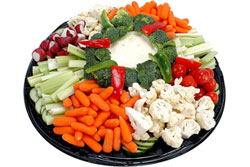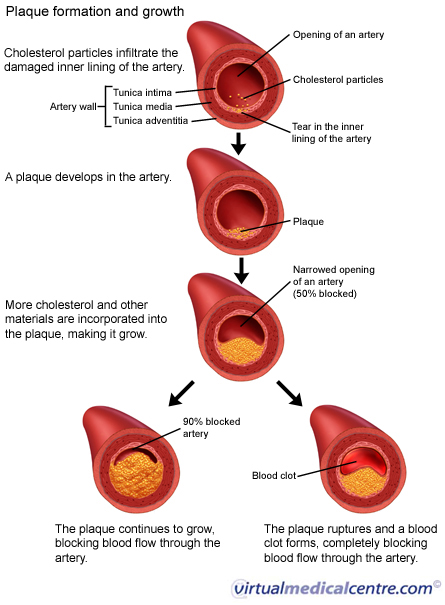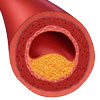- What is cholesterol?
- Why is LDL cholesterol unhealthy and HDL cholesterol healthy?
- What raises cholesterol levels?
- Achieving and maintaining optimal blood cholesterol levels
What is cholesterol?

Cholesterol-carrying lipoproteins play a central role in the development of atherosclerotic plaque and cardiovascular disease. There are two main types of lipoprotein, low density and high density. These lipoproteins work in opposition to each other. Low density lipoproteins carry cholesterol from the liver to the rest of the body. High density lipoproteins carry cholesterol from the blood back to the liver, which processes the cholesterol for elimination from the body. Low density lipoprotein (LDL) cholesterol is usually referred to as “bad” cholesterol; and high density lipoprotein (HDL) cholesterol as “good” cholesterol.
Both dietary changes and drugs are used in the management of cholesterol levels. In most cases, the dietary approach is the first option, since dietary habits have a great influence on the cholesterol levels of an individual.
Why is LDL cholesterol unhealthy and HDL cholesterol healthy?
An unhealthily high level of cholesterol is called hypercholesterolaemia. A total cholesterol level less than 200 mg/dl (milligrams of cholesterol per decilitre of blood) is considered desirable. Cholesterol concentrations of 200-239 mg/dl are deemed to be borderline high risk, while levels of 240 mg/dl or more are considered to put one at high risk of cardiovascular diseases.
Excess LDL cholesterol will build up on the artery walls, forming deposits of cholesterol called plaques. A build up of plaques in the arteries will make them narrower and may eventually block blood flow to the heart. This narrowing of blood arteries, called atherosclerosis, can restrict blood supply to the heart, impairing oxygen and nutrient supplies. Such a situation can lead to chest pain known as angina. Furthermore, plaques can rupture, causing blood clots that may lead to heart attack, stroke, or sudden death.

This explains why LDL is considered the “bad” cholesterol. HDL cholesterol, on the other hand, can remove some of the cholesterol already attached to the artery walls. HDL makes it less likely that excess cholesterol in the blood will be deposited in the coronary arteries, which is why HDL cholesterol is often referred to as the “good” cholesterol.
In general, the higher your LDL and the lower your HDL, the greater your risk for atherosclerosis and heart disease. Therefore, the guiding principle is to strive for low bad cholesterol and high good cholesterol.
What raises cholesterol levels?
A number of factors can affect your blood cholesterol level, including family history, age, gender, eating habits, body weight and shape, and level of physical activity. Evidence from research suggests that the cholesterol we eat is not the greatest determinant of the cholesterol levels in our blood. Rather, it is the amount of saturated and trans fats we consume. For example, eggs may be high in dietary cholesterol, but they don’t contain much saturated fat.
Saturated fats are mainly animal fats and can be found in meat, seafood, whole-milk dairy products (cheese, milk, and ice cream), poultry skin, and egg yolks. Some plant foods (including coconut and coconut oil, palm oil, and palm kernel oil) are also high in saturated fats. Saturated fats raise total blood cholesterol levels more than dietary cholesterol because they tend to boost both good HDL and bad LDL cholesterol.
However, monounsaturated fats and polyunsaturated fats (found in nuts and fish), can lower the LDL level, as can soluble fibre (found in fruits, oats, barley and legumes).
This information will be collected for educational purposes, however it will remain anonymous.
Achieving and maintaining optimal blood cholesterol levels
Dietary changes are often the first things attempted to try to lower cholesterol levels. Losing weight, exercising and cutting down on “bad” fats are the cornerstones of a cholesterol-lowering lifestyle. Also, the excess calories that you consume, regardless of where they come from (carbohydrates, fats or protein), will be transformed into triglycerides for storage as body fat.

- Avoid excessive food intake and maintain an active lifestyle by exercising regularly. Physical activity can help raise HDL levels and thereby lower cholesterol level.
- Eat a healthy diet low in saturated fats and trans fats. This can be achieved by:
- Using low fat dairy products
- Trimming meat purchased from shops of any visible fats
- Cooking with oil from vegetable sources (e.g. olive, peanuts, soya, and canola) instead of animal derived fats (e.g. butter).
- Try to limit the amount of trans fats. A study conducted in the USA by the Institute of Medicine has concluded that there is no safe level of trans fats in the diet.
- Include the consumption of foods high in soluble fibre (e.g. whole grains, kidney beans, barley, oatmeal and fruits such as apples and pears). Soluble fibre lowers the bad LDL cholesterol without lowering the good HDL cholesterol. 5-10 grams of soluble fibre a day decreases LDL cholesterol by about 5%.
- Limit sugar intake by avoiding sweetened beverages (soft drinks, some juices, tea/coffee with sugar added).
- Limit excessive intake of alcohol.
- Include foods rich in omega 3 fatty acids (e.g. salmon and flax seed), which has been shown to lower LDL cholesterol and raise HDL cholesterol. Omega 3 fatty acids in particular are noted for their triglyceride-lowering power. Studies suggest that eating just 6 oz per week of fatty (dark meat) fish (e.g. salmon, herring, mackerel, anchovies, or sardines) may be enough to reduce the risk of dying from heart disease by 36%.
- Moderate consumption of nuts rich in fibre, phyto-nutrients and antioxidants such as vitamin E and selenium will help lower the bad LDL cholesterol.
- Include foods fortified with plant sterols because they have the ability to block cholesterol absorption.
- Monitor your weight and maintain a healthy body weight at all times. You can easily calculate your body mass index (BMI) to find out whether your weight falls within the healthy range.
This information will be collected for educational purposes, however it will remain anonymous.
More information
 |
For more information on cholesterol, including the health effects of high cholesterol and ways to lower cholesterol levels, as well as some useful tools, see Cholesterol. |
 |
For more information on nutrition, including information on types and composition of food, nutrition and people, conditions related to nutrition, and diets and recipes, as well as some useful videos and tools, see Nutrition. |
References
- Mensink RP, Zock PL, Kester AD, Katan MB. Effects of dietary fatty acids and carbohydrates on the ratio of serum total to HDL cholesterol and on serum lipids and apolipoproteins: A meta-analysis of 60 controlled trials. Am J Clin Nutr. 2003;77(5):1146-55. [Abstract | Full text]
- Institute of Medicine of the National Academies. Dietary reference intakes for energy, carbohydrate, fiber, fat, fatty acids, cholesterol, protein, and amino acids. Washington, DC: National Academies Press; 2002. [Book]
- Brown L, Rosner B, Willett WW, Sacks FM. Cholesterol-lowering effects of dietary fibre: A meta-analysis. Am J Clin Nutr. 1999;69(1):30-42. [Abstract | Full text]
- Lipsky H, Gloger M, Frishman WH. Dietary fiber for reducing blood cholesterol. J Clin Pharmacol. 1990;30(8):699-703. [Abstract]
- Mozaffarian D, Rimm EB. Fish intake, contaminants, and human health: Evaluating the risks and the benefits. JAMA. 2006;296(15):1885-99. [Abstract | Full text]
- Thomsen AB, Hansen HB, Christiansen C, Green H, Berger A. Effect of free plant sterols in low-fat milk on serum lipid profile in hypercholesterolemic subjects. Eur J Clin Nutr. 2004;58(6):860-70. [Abstract | Full text]
All content and media on the HealthEngine Blog is created and published online for informational purposes only. It is not intended to be a substitute for professional medical advice and should not be relied on as health or personal advice. Always seek the guidance of your doctor or other qualified health professional with any questions you may have regarding your health or a medical condition. Never disregard the advice of a medical professional, or delay in seeking it because of something you have read on this Website. If you think you may have a medical emergency, call your doctor, go to the nearest hospital emergency department, or call the emergency services immediately.







